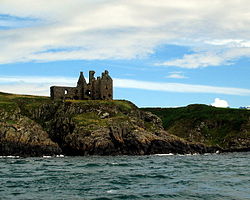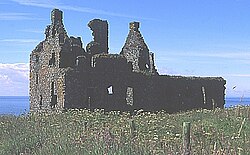Dunskey Castle
| Dunskey Castle | |
|
Wigtownshire | |
|---|---|
 Dunskey Castle | |
| Location | |
| Grid reference: | NX00375340 |
| Location: | 54°50’7"N, 5°6’36"W |
| History | |
| Information | |
| Condition: | Ruined |
| Owned by: | Dieter Stanzeleit |
Dunskey Castle is a ruined, 12th century tower house or castle in Wigtownshire, standing half a mile south of the village of Portpatrick on the Rhinns of Galloway.
The castle is listed as a scheduled monument, a 'nationally important' archaeological site or historic building, given protection against unauthorized change. It is also a class A listed building.[1][2]
Description
The castle is on three storeys, in an L-plan, sited on a promontory, with a rock-cut ditch, 49 feet wide by 8 feet deep, defending the only access, from the north-east.[1] The castle measures 100 feet by 47 feet, with walls 5 feet thick, although the building is now a roofless shell. The north-east wing is of a later date, and the foundations of a south range are visible.
Near the castle are the remains of a watchtower, 23 feet square, built on the cliff edge.[3] Timothy Pont's map drawn c.1580-1590 shows Dunskay Castle with 2 watchtowers on the cliff edge fronting the sea.[4] Francis Grose's drawing dated 10 May 1790 shows the ruins of the foundations and sea-wall on the south and what looks to be the large entrance door in the southern corner from where the inside staircase may have led straight up to the new "Hall" built c.1520. Grose's drawing shows Ireland (approx. Island Magee / Larne area) in the background across the sea.[5]

In virtue of a tradition preserved in the Book of Leinster, W. J. Watson identifies the place named in it as Port Rig (Portrie, Portree) with the later Portpatrick, connecting `Rig' with Reregonium, which he regards as the royal town of the Novantae and places in this region. He would thus carry Portpatrick's history back to the first century of our era, while he dates a rather later reference to about 250.[6] Portpatrick was known as the port of Castle Dunskey.
Dunskey is undoubtedly romantic. It was a location for the 1951 film "Kidnapped" of Robert Louis Stevenson's novel.
The ruin is privately owned and public access is restricted.
History
Little is known of the castle's early history as it was held with other estates. In the early modern period, it is recorded as within the estates of William Adair "10 lib. terranium de Portrie cum castro de Dunskey in parochie de Inche.[7] Sir Robert McClellan (McLellan) of MacLellan's Castle Kirkcudbright in 1614 married Mary Montgomery, eldest daughter of Sir Hugh Montgomery, 1st Viscount Montgomery of Ards, County Down,[8] and in 1620 it was amongst the lands acquired by Sir Hugh. He extended the castle by building the "Gallery" leading off from the "Hall" and vaults under the "Gallery".[9]
A letter of 24 August 1632 from Sara Maxwell, Viscountess Montgomerie records:
"It seameth ye ar causing your workmen goe on both in your building and theikine of your Gallerie att Dunskay. They ar necessarie thingis to be outride, seeing ye have put theme so far agait. Bot I am suire they ar greit chargeis vnto yow quhilk now can noght be helpeit ; bot your lordship most compleit thame, as ye haue done many greater turne."[10]
Timothy Pont's map 1654 shows "Two castles stronger than the rest may be seen in the Rinns, Kennedy on Loch Isle of the Earl of Cassillis, and Scaeodunum (called in the vernacular Dunskey), (Scot dun / castle ? ) founded by the ancestors of Robert Adair on a sheer rock by the sea."[11]
Viscount Montgomery was heavily in mortgage after sustaining his troops for a long period, (as was Sir Robert McLellan), so Dunskey Castle passed to the Blair family who were or had been Ministers at ‘Portmontgomery’ alias Portpatrick.[12]
By 1684 Dunskey Castle was in ruin, only 50 years after Viscount Montgomery had added the new gallery wing extensions.
Outside links
| ("Wikimedia Commons" has material about Dunskey Castle) |
References
- ↑ 1.0 1.1 Dunskey Castle Listed Building Report
- ↑ Certificate - Dunskey Castle (Commissioners of HM Works 9 November 1938
- ↑ Dunskey Castle - CANMORE (RCAHMS) - RCAHMS
- ↑ National Library of Scotland http://maps.nls.uk/atlas/blaeu/page.cfm?id=95
- ↑ "The Antiquities of Scotland, volume 2, pp.191-192, by Francis Grose, pub. 1791 by Hooper. http://books.google.com.au/books?id=Ai0DAAAAYAAJ&q=Dunskey#v=snippet&q=Dunskey&f=false
- ↑ History of the Celtic Placenames of Scotland. http://www.spns.org.uk/watsdg.html
- ↑ Retours of Service of Heirs, Inquisitions Specials - Wigton. p.33
- ↑ The Scots Peerage. Volume V p.267
- ↑ Register of the Great Seal of Scotland, vol.VII, p.772, no.2127. https://archive.org/stream/registrummagnisi07scot#page/772/mode/2up
- ↑ The Montgomery Manuscripts. Vol.I by William Montgomery, ed. Rev. George Hill, pub. AD1869. p.112 Montgomery Letters
- ↑ National Library of Scotland. Blaeu Atlas of Scotland, Pagination: 50. Title: Gallovidiae. http://maps.nls.uk/atlas/blaeu/page.cfm?id=95
- ↑ Register of the Great Seal of Scotland, Vol. IX. AD1634-1651. p. 814 #2156 Apud Edinburgh, 10 Jan (1649)REX, - concessit et de novo dedit M. JACOBO BLAIR ministro Verbi Dei apud ecclesiam de Port-Montgomrie ejus heredibus, successoribus et assignatis quibuscunque, irredimabiliter, - 4 mercatas terrarum de Meikle Portspittell, 3 mercatas de Litle Portspittell.(THE KING consents to a new deed to Rev. James Blair, minister of church at Port-Montgomery as well to his heirs, assigns [etc] four marks of land of Great Portspittell, three marks at Little Portspittell
